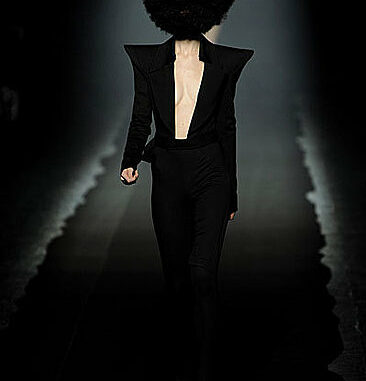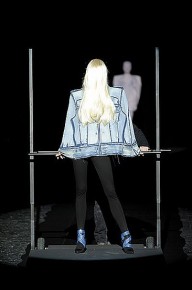
We will always follow a veil. Inquisitive and curious by nature, we want to know all there is to know. This is the unique charm of Maison Martin Margiela: the house has us hooked: because no matter how much we know, we’ll never know it all.
Shrouded in silence, this is one of the first conceptual, avant-garde brands to have maintained an allure of its own. A sense of righteous anonymity sits at the heart of Maison Martin Margiela and has firmly established itself into the DNA of the brand. This strategy, if that’s what we can call it, is part of the house’s signature and perhaps the basis for their continued success and on-going longevity, despite Martin Margiela’s departure in 2009.
Having denounced the path of mainstream fashion, there is no face, no main man; only the concept and the collection coming from a choir of designers working in perfect harmony. They refuse to use any physical image of a designer or famous face of a model to increase their popularity; instead, they want you to react to the garment itself. “The only thing we wish to push forward is our fashion”, they bleat in perfect symmetry.
They always communicate as a company too, never as a person. While Margiela ruled the roost, any inquisitors wishing to penetrate the murky workings of his mind were instructed to send questions to the house, to be answered by his team collectively. The maison does the talking; that was the message. And so, from a label that has always insisted on “we” instead of “I”, they have become more than just a brand – they’re a family. The maison with morals: doing things differently with thought-provoking, heavy rooted collections that make you think. Fashion is clever, don’t you know? That’s their point.
 To get behind the essence of Margiela’s methodology, it’s important to understand the role that anonymity has had through the brand’s history. Silence stems back to its co-founder, Martin Margiela, the Messiah of fashion: the anti-designer of design: the Godot of this industry. This is the guy who shunned the face of fashion and yet remained its most influential figure. He didn’t do interviews, never appeared on the runway, nor did he take one minute of glory or credit for a collection. In an industry which relies so heavily on contacts and popularity he remained an anonymous anomaly and ironically despite his best efforts, his anonymity became louder and increasingly interesting to the media. For Martin though, this was never a smoke-screened masquerade but a heartfelt move away from the prevailing cult of celebrity culture – a natural resistance and refreshing revolt against the fifteen minute hall of fame.
To get behind the essence of Margiela’s methodology, it’s important to understand the role that anonymity has had through the brand’s history. Silence stems back to its co-founder, Martin Margiela, the Messiah of fashion: the anti-designer of design: the Godot of this industry. This is the guy who shunned the face of fashion and yet remained its most influential figure. He didn’t do interviews, never appeared on the runway, nor did he take one minute of glory or credit for a collection. In an industry which relies so heavily on contacts and popularity he remained an anonymous anomaly and ironically despite his best efforts, his anonymity became louder and increasingly interesting to the media. For Martin though, this was never a smoke-screened masquerade but a heartfelt move away from the prevailing cult of celebrity culture – a natural resistance and refreshing revolt against the fifteen minute hall of fame.
Hiding quite happily in the shadows, the maison is far above and beyond the norm. Buying into Margiela is buying into a movement; entering a Margiela store is more than a shopping trip and likewise, wearing Margiela is so much more. These aren’t just clothes; this is a way of life. Purchasing a Margiela piece must feel like joining the Mafia of the fashion industry: they are one elusive, close-knit cocoon of a network labouring away underground: dropping little crumbs of hidden codes to be found and decoded for all those who are on the lookout and wish to see. All very Hansel and Gretel, don’t you think?
So, with this strict no logo philosophy, they codify their world to the tiniest degree. Those white tags and four signature stitches are part of an intimate numerical system. Three rows of ten numbers are printed on each of his labels and above his shops. Collections are identified by a circled number. Stores are never listed in phone books. Packaging is monochrome and logo free. Seating is mostly first-come, first-served, snubbing the industry standard of seating hierarchy. Hallelujah! Some equality.
The difference is definitely in the detail, and it’s this, their code of conduct that sets them apart from the industry standard. Conceptually speaking, they’re on a different level, bringing forward intellectually challenging collections season after season. Margiela was christened one of the six Antwerps and is the grandfather of European avant-garde, after all: deconstructing and reconstructing has always been the name of his game. He is famous for his innovations: for his ingenious solutions to how a garment can be reimagined.  You could call it clever recycling, but it definitely goes beyond that. It’s more like seeing beyond the garment and then resuscitating the life back into it. As the Queen Bee said when in the thick of it, it’s not about being destructive but rather a way of “bringing them [clothes] back to life in a different form.”
You could call it clever recycling, but it definitely goes beyond that. It’s more like seeing beyond the garment and then resuscitating the life back into it. As the Queen Bee said when in the thick of it, it’s not about being destructive but rather a way of “bringing them [clothes] back to life in a different form.”
Not surprisingly, the medium through which Maison Martin Margiela reveal their next movement is different and more distinguished than anything anyone is doing right now. Collections, for example, have been shown in dilapidated warehouse spaces; in disused subway cars; in the stairwell of a crumbling town house. On one particular occasion, press were instructed to travel to some street corner in the French capital and await the arrival of a Routemaster bus (filled with the former designer’s friends all wearing his new season’s designs). The video sent out after the event only added to the characteristically surreal nature of it. “Please turn your TV this way up,” read the instructions. The entire show had been filmed on its side and oom- pah- oom-pah went the Belgian brass band in the background.
For his final collection, Margiela went the introspective route and celebrated all that had been before. It was a very fitting end to a very memorable journey. Of course, all of the models were faceless – a loyal nod to the designer’s lifelong obsession with anonymity – and the white lab coat (the house uniform) came out in various forms, including the final bow, when the entire staff emerged on the runway rather than Margiela himself. The anniversary proved the maison was light years ahead of its time. Ever since that collection and Margiela’s departure, the brand has continued to take giant leaps for mankind – collections continue to push, shove and prod the very definition of clothing – and you can guarantee every show will be another deconstructed rollercoaster of a ride that will have you on the edge of your seat all the way through.
The late McQueen said, “Of course I like Martin Margiela. I’m wearing him now. His clothes are special because of the attention to detail. He thinks about everything, the cuff of a jacket, the construction of an armhole, the height of a shoulder. I think it’s very much about cut, proportion and shape, the simplicity of it, the pared down-ness of it. His clothes are modern classics.” The hand of Margiela has been firmly removed, but the maison has kept the cult going with resounding success. True to form, the maison remains as removed from the hysteria and histrionics that surround the fashion industry as ever: and that’s how it should be. While their silence is maintained, the work continues to speak volumes.


Leave a Reply